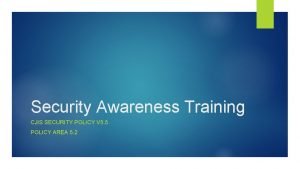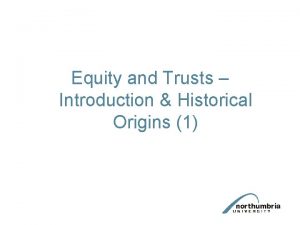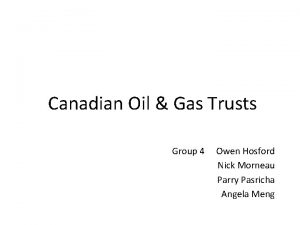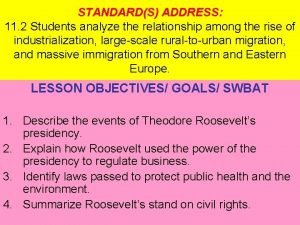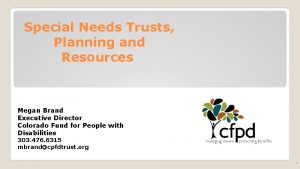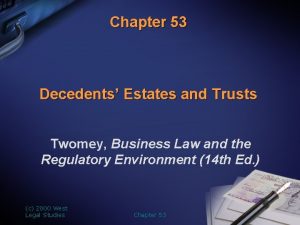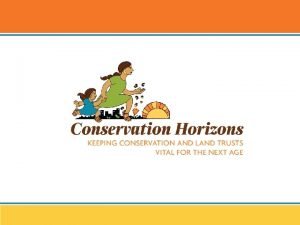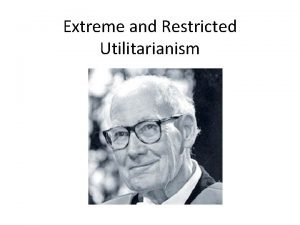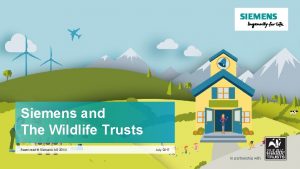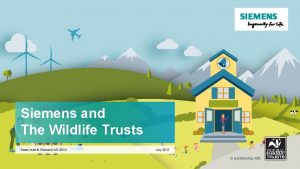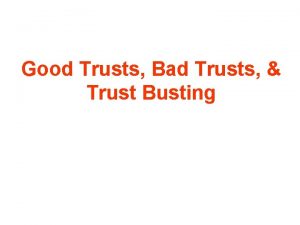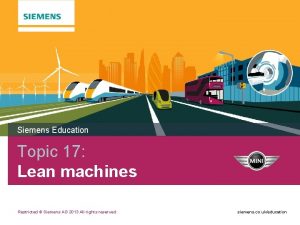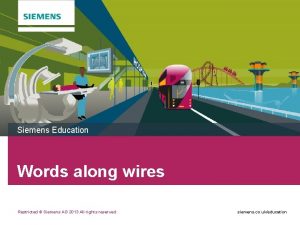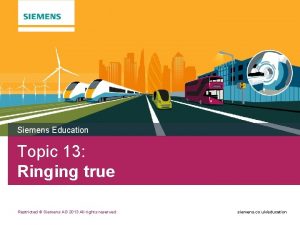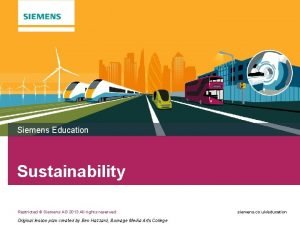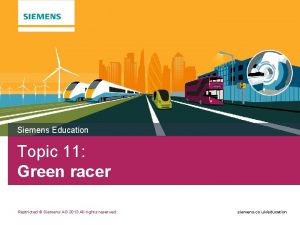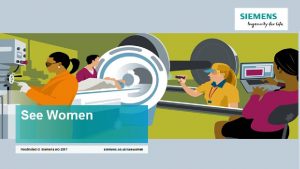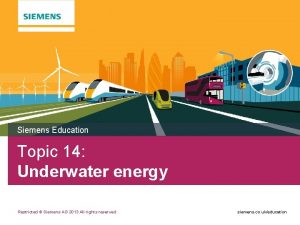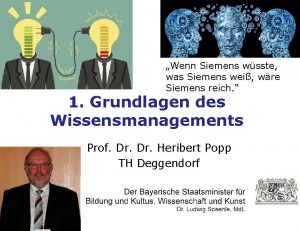Siemens and The Wildlife Trusts Restricted Siemens AG

















- Slides: 17

Siemens and The Wildlife Trusts Restricted © Siemens AG 20 XX July 2017 In partnership with

Lesson 1 - Carbon In partnership with

Learning Objectives • To understand what greenhouse gases are, what they do, and how they affect the natural world • To understand the atmospheric cycle and how this affects global warming • To gain an understanding of the impacts of climate change • To identify how we can reduce our carbon footprint in everyday life In partnership with

Learning Outcomes • To understand how greenhouse gases work • To identify the effects global warming will have • To understand how we can reduce our carbon footprint In partnership with

How does the Greenhouse effect work? 3 1 1 Sunlight passes through the atmosphere and warms the Earth 2 Infrared radiation (IR) is given off by the Earth. Most IR escapes to outer space and cools the Earth 3 But some IR is trapped by gases in the air and this reduces the cooling effect. 2 In partnership with

We can model this using the Greenhouse Effect Coats Game The game is played with one person in the centre of a circle (the Earth) and other people in a circle outside with their coats (the GHGs). In partnership with

How does the Greenhouse effect work? • Climate change is a large-scale, long-term shift in the planet's weather patterns or average temperatures. It is a natural process that would happen irrespective of human interference. • Global warming is the measured increase in average temperature of the planet's surface – Average temperature has risen by 0. 89 C from 1901 to 2012. The rate of temperature’s rise since the Industrial Revolution is extremely high compared to any other period in History. This is believed to be caused by man made Carbon Emissions from various sources such as Hydrocarbon Fuels like Coal and Natural Gas. In partnership with

Global Warming’s Effects Retreating ice cover • Ice sheets occur at the poles, and have been shrinking over the last 100 years. Arctic sea ice reaches its minimum each September and is now declining at 13. 2% per decade, comparative to the 1981 to 2010 average. • Glaciers all over the world - in the Alps, Rockies, Andes, Himalayas, Africa and Alaska - are melting and the rate of shrinkage has increased in recent decades. This isn’t the case for all glaciers however. A few have actually grown, receiving greater snow fall due to changing weather patterns. In partnership with

The Impacts of Climate Change on Wildlife Watch the video to learn more about retreating ice Did you know…… Eric Larsen and Ryan Waters’ 2014 expedition from the northern tip of Canada’s Ellesmere Island to the geographic North Pole, may be the last time anyone can walk from land to the Pole, because the extent of Arctic sea ice has decreased so dramatically! In partnership with

Global Warming’s Effects Sea level rises Rising sea levels are mostly caused by thermal expansion of sea water, due to increasing temperature. Increasing melted water from ice sheets and glaciers also adds to the problem but to a lesser extent. This graph shows the change in sea level since 1993 as observed by satellites. In partnership with

The Impacts of Climate Change on Wildlife There is strong evidence that climate change is already affecting our UK biodiversity. Many species are occurring further north and at higher altitudes (e. g. the Adonis blue butterfly pictured) than in previous decades. Although a warmer climate will benefit some species, this is likely to be countered by negative impacts for others and extreme weather events. The same goes for some of our most iconic landscapes and habitats, including wetland, heathland some types of woodland. www. wildlifetrusts. org In partnership with

The Effects of Climate Warming on Wildlife High spring rainfall, for example, can negatively impact on birds, causing reproductive failures and poor chick condition. In west Scotland, golden eagle populations declined by 25% when there was a significant increase in May rainfall. Flooding has a negative impact on almost all mammals, except bats, when large areas of land are inundated with floodwater during spring and summer, nests and burrows are flooded causing the young to drown or die from cold. www. wildlifetrusts. org In partnership with

Global Warming’s Effects What does this mean for the UK • Rainfall has increased in the mid-latitudes of the northern hemisphere since the beginning of the 20 th century. There also changes between seasons in different regions. For example, the UK's summer rainfall is decreasing on average, while winter rainfall is increasing. There is also evidence that heavy rainfall events have become more intensive, especially over North America. • Effects on humans include flooded houses, lost road links, people running out of food and reduced access to medical support. Effects on nature include submerged land, isolated wildlife and food shortage. Preventative measures include flood defences, planting trees, canalising rivers, drainage planning, porous pavement, decarbonising energy. In partnership with

Global Warming’s Effects Case study Manchester, Lake District Floods Follow the link in the image to watch Helicopter footage showing the scale of the 2015 Cumbria floods. Helicopter footage reveals the scale of widespread flooding in Cumbria as flood water reach their peak in the wake of Storm Desmond. Hundreds of homes have been flooded and more than 1, 000 people evacuated in Cumbria and the Scottish Borders In partnership with

Your Carbon Footprint Water Emissions Fuel Personnel Gas Electricity Recycling Watch this video: www. youtube. com/watch? v=8 q 7_a. V 8 e. LUE Use the worksheet to find out the number of pounds of carbon dioxide per year you use. The lower the number, the fewer greenhouse gases are emitted into the atmosphere Transport Offsets Waste In partnership with

The Impacts of Climate Change on Wildlife A satellite survey by a research team at the University of Leicester found that between 2006 and 2012, 54, 000 acres of green space was converted to synthetic surfaces, mostly housing. 14, 000 hectares of woodland was concreted and 1, 000 hectares of wetland was drained to make way for urban extension. Urban parks contribute to environmental benefits. This is because parks and open spaces that include protected natural lands, ecological reserves and wetlands are critical to providing healthy habitats for humans, wildlife and plants in densely built up areas. Dronepicr CC In partnership with

The Impacts of Climate Change on Wildlife Parks can also help create energy efficient cities to slow global warming, as plants absorb CO 2 and NO 2 emissions via leaf stomata or the plant surface. Open spaces make compact living attractive and feasible. Trails link individual parks making it easier for people to bike and walk. Additionally old rail lines can be transformed into greenways. Beyond my own Ken photography CC In partnership with
 Ncic restricted files
Ncic restricted files Cjis meaning
Cjis meaning Industrialists of the late 1800s used pools and trusts to
Industrialists of the late 1800s used pools and trusts to Industrialists of the late 1800s used pools and trusts to
Industrialists of the late 1800s used pools and trusts to History of equity and trusts
History of equity and trusts Equity and trusts charities problem question
Equity and trusts charities problem question Oil sands extraction process diagram
Oil sands extraction process diagram What legislation helped solve dangerous food and medicines
What legislation helped solve dangerous food and medicines Why are the trusts portrayed as vultures
Why are the trusts portrayed as vultures Content filtering trusts
Content filtering trusts Special needs trusts colorado
Special needs trusts colorado Parshvanath charitable trust
Parshvanath charitable trust Neville estates v madden
Neville estates v madden Development trusts ni
Development trusts ni 53 trusts
53 trusts California land trusts
California land trusts T-closeness
T-closeness Extreme and restricted utilitarianism
Extreme and restricted utilitarianism

